Menus
- Production racer based on the 500 factory machine
- Lap average of 209 km / h
- 24 BMW RS 54s left the factory halls
- Officially 45 hp at 8000 rpm
- Converted to a racing team
- BMW RS 54 in the Stockholm Motorcycle Museum
- Technical specifications
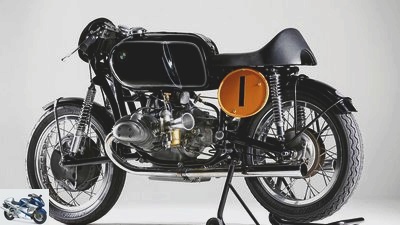
Osterling
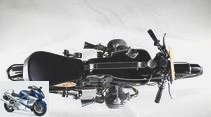
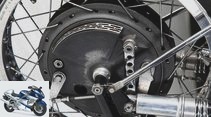
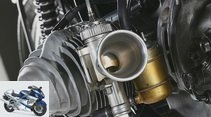
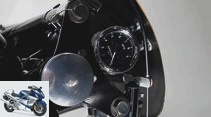
7th photos
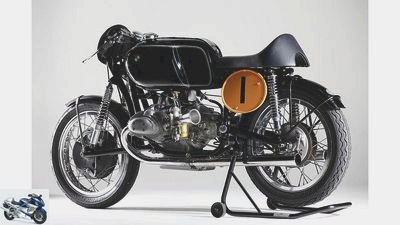
Osterling
1/7
BMW RS 54.
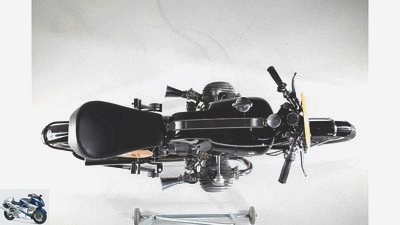
Osterling
2/7
Narrow, short, light the RS 54 weighs only 132 kilograms.
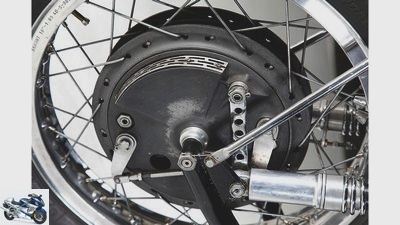
Osterling
3/7
Not original: Like the factory racing machines from BMW, our photo model also has a retrofitted double duplex drum brake in the front wheel, which puts the standard brake of the RS 54 in the shade.
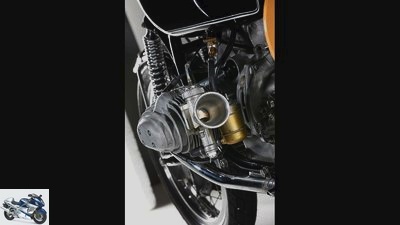
Osterling
4/7
Larger Dellorto carburettors were standard modifications at the time.
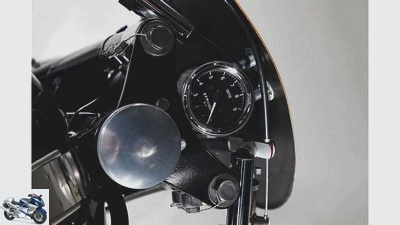
Osterling
5/7
Always in the spotlight: the Smiths tachometer. The RS 54 achieved its rated output of around 45 hp at 8000 tours, and the versions tuned here with larger carburettors and higher compression turned even higher.

Osterling
6/7
BMW RS 54.
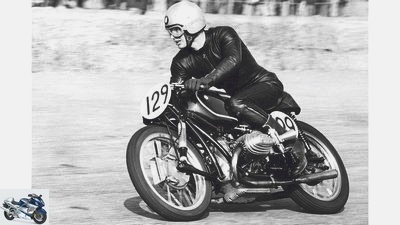
Osterling
7/7
Dynamic duo: the author Bo Rindar in 1962 with his BMW RS 54. Like so many other pilots, the later Swedish BMW importer also had difficulties with the extremely expensive production racer, which had to be used to getting used to.
BMW RS 54 in the studio
Production racer based on the 500 factory machine
Content of
For private drivers, BMW built a production racer based on the 500 cc factory machine in 1954. Despite the horrific prices, the RS 54 was not a great success as a solo machine. However, their vertical shaft boxer became a legend, which dominated this class as a team drive for 20 years and won a total of 19 world titles.
NAfter the Second World War, Germany was banned from participating in international motorsport until 1951. There were still motorcycle races, but only on home soil. From 1947 to 1950, the main drivers were charged pre-war machines, with BMW bringing in the most victories with “Schorsch” Meier. When the ban on German drivers and manufacturers was lifted in 1951, the Munich-based company had to develop a new 500cc racing machine to re-enter the motorcycle world championship, as the world association FIM had already banned supercharged engines after the end of the war.
Lap average of 209 km / h
The difference between a 500 cc naturally aspirated engine and a supercharged 500 cc was enormous, as the following figures illustrate: Georg Meier won the Grenzland-Ring in 1950 with a supercharged BMW with a lap of 209 km / h, and he even drove on his best lap an average of 216 km / h – and that on a naked racer without aerodynamic aids. BMW never published official performance data, but in the last compressor season in 1950 it must have been around 78 to 80 hp.
The simplest solution to meet the FIM regulations, namely to remove the compressor and help the engine with classic tuning, was of course not a viable one. Because an engine designed for supercharging no longer works at all after such castration. Nothing fits, from the ducts in the cylinder head to the insufficient compression to the valve angle and control times, which have to be radically different in a naturally aspirated engine. It goes without saying that such an emasculated ex-compressor boxer could at best release an output of 40, maybe 42 hp. Too little to be competitive in the new 500cc class, that much was soon clear.
24 BMW RS 54s left the factory halls
It was not until 1953, however, before Meier and the young Walter Zeller were allowed to drive the prototype of the new 500 cc racing boxer for the first time. It had a modern double loop frame, instead of a telescopic fork and straight-line suspension, the front and rear wheels were guided in long-arm swing arms. In the spring of 1954, the RS 54, derived from the factory racer, was presented as a commercially available solo machine for private drivers. Of these, a total of 24 left the factory halls (a 25th is being discussed), plus four teams (in retrospect, a reverse distribution would have been more useful). The price for the solo machines – although never precisely quantified – was astronomical at the time. The Norton Manx, a racing machine that was also commercially available, is said to have cost only a third in the mid-1950s.
While an R 51/3 had a square bore / stroke ratio (68 x 68 millimeters), the RS 54 engine was a long-stroke engine (bore x stroke: 66 x 72 millimeters). Noteworthy insofar as less stroke would also have meant less overall width. Two 30 mm carburettors from Fischer-Amal (Amal carburettors manufactured under license) took care of the mixture preparation, whereas BMW relied on Bing products for the production models. The mechanical stability of an RS 54 was very similar to the high-volume products. The Konigswellen racing boxer ran and ran, the reliability in racing was really remarkable. Compared to the competition, the RS also surprised with its exceptional manufacturing quality. Back then it was unique in the racing scene, which made an RS 54 all the more attractive for private drivers.
Officially 45 hp at 8000 rpm
No wonder in view of the great technical effort. A total of six spur gears and seven bevel gears were required for the valve train via vertical shafts and two overhead camshafts with rocker arms. The short, rigid crankshaft with an additional central segment made high speeds possible, the forged pistons ran in light-metal cylinders with hard-chrome-plated liners, and the exhaust valves were filled with sodium for better heat dissipation. BMW officially named an output of 45 hp at 8000 rpm, sufficient for private drivers without ambitions for a world title. A Norton Manx didn’t have any more power at the time, but it weighed 20 pounds more than the 132 kilogram RS 54.
Osterling
Narrow, short, light the RS 54 weighs only 132 kilograms.
Nevertheless, the RS 54 did not make things easy for its pilots, most of them had their difficulties with the peculiarities of the nervous chassis, a double loop frame that was very similar to Norton’s feather bed. The problems resulted mainly from the very short wheelbase of just 1370 millimeters, and the BMW became quite restless at high speeds. In the 1950s, it was still unknown that a direct connection between the steering head and the swing arm bearing is beneficial for driving stability.
As long as it stayed at the specified 45 hp, the overall package worked reasonably well. But when – as with most RS 54s – the Fischer-Amal was exchanged for a 32-series Dellorto SSI and the compression was increased from eight to 10: 1, things looked different. The performance boost pushed the chassis to its limits even faster; it sometimes showed a truly unsettling life of its own. Like so many others, I didn’t really get along with this motorcycle in my short racing career with solo machines. For the 1963 season, I had the engine overhauled, naturally with higher compression pistons. This made the engine run a lot more lively, but after qualifying a competitor growled: “It’s enough if you are at the front, then you win. You need the whole distance, nobody will dare to overtake you …”
Converted to a racing team
Sure, that was a bit of an exaggeration, but it still describes the misery with the BMW impressively. My own successes with the machine were correspondingly modest: In 1962 I finished third in the Swedish championship in the 500, and the following year it was fourth. After I sold the BMW in the fall of 1963, the new owner converted it into a racing team, which is not an unusual fate of these rarities.
The most important thing on a racing motorcycle is that the driver feels comfortable on it. Unfortunately, that was not the case with the RS 54 and me. And if both trust and driving pleasure are lacking, you will follow, no matter how fast the motorcycle is. In the following season I drove a tuned and radically converted production BMW based on the R 50 S. It had less power and more weight. And yet I was faster with it than with the RS 54 on the same routes!
Despite everything, the RS 54 left a lasting impression on me. Mine was the only one that made it to Scandinavia as a new vehicle. From the spring of 1954 it was used by a Finn who had already passed his driving zenith but had enough money for it. Two years later, Evert Carlsson, a Swede, took over the machine. But even then, as a racing driver, he was only a shadow of himself. When I bought the RS in autumn 1961, at just 22 years old, I was by far the youngest owner. But that didn’t help. After me, the BMW, which had meanwhile been converted into a racing team, was owned by a Swede and a Finn – both were already over 40 at this point.
BMW RS 54 in the Stockholm Motorcycle Museum
However, the model on these pages comes from Germany. It was restored by Ewald Dahms in the 1990s and then sold to Karl Ibscher in 1997, who used this RS 54 in classic races and retrofitted a larger-sized double duplex brake at the front, just like the factory racers. Two years ago, the Stockholm Motorcycle Museum bought this rare BMW (www.mc-collection.com).
Osterling
Larger Dellorto carburettors were standard modifications at the time.
Compared to the RS 54 customer machines, the BMW works racers had more power. Walter Zeller got a short stroke (70 x 64 mm) for 1955 that rotated up to 9500 rpm without flying to pieces. For fast courses like Monza, Spa or Hockenheim, mechanical injection from Bosch was also used, which exceeded the 58 hp with carburettors by three hp. The carburettor variant had an advantage on narrower stretches, it brought more torque in the middle. In 1956 the factory engine ran really well, Zeller finished second in the World Championship behind John Surtees on MV Agusta. The BMW was lighter than the four-cylinder competition, with full fairing the top was around 245 km / h. When Walter Zeller stopped running the family business in 1957, Geoff Duke was hired. But he never really got on with the machine, it was only enough to win at Hockenheim in 1958. Dickie Dale, on the other hand, was more successful, at least he managed a third place in the 1958 World Cup.
The BMW works machine differed in many details from the RS 54. At the front, a double duplex brake decelerated, the rear counterpart was operated hydraulically. It also had a double-jointed cardan drive with a parallelogram swing arm, which minimized annoying load change reactions. But these were only the obvious differences, it can be assumed that the chassis itself was also more stable.
However, the RS 54 engine celebrated its greatest successes in the sidecar class, where it won 19 world titles between 1954 and 1974. BMW saw the potential of the engine as early as the 1950s and manufactured a (small) number of short-stroke engines. They were sold to private drivers, mostly from Germany and Switzerland. The boxer lowered the center of gravity of the racing teams, which gave them better cornering grip and, thanks to the smaller frontal area, higher speeds. In addition, there was the already mentioned reliability, which enabled regular target arrivals. According to insiders, however, the engine output never exceeded 65 hp. When Klaus Enders took home his sixth world title in 1974, it was also the last title for BMW. 1974 was also the turning point for the solo machines: Phil Read on the MV Agusta was the last time a four-stroke machine won the 500 World Championship.
Technical specifications
Osterling
BMW RS 54.
Engine:
Two-cylinder four-stroke boxer engine, two vertical shafts and two overhead camshafts and rocker arm actuated valves per cylinder, 66 mm bore, 72 mm stroke, 492 cm³, compression 8: 1, approx. 45 hp at 8000 / min, two 30 Amal -Fischer round slide carburettor, dry clutch, four-speed gearbox, cardan drive
Landing gear:
Double-loop tubular frame, long arm swing arm at the front, two-arm swing arm at the rear, duplex full-hub brake at the front, full-hub drum brake at the rear, dry weight 132 kg, tank capacity 24 l
Top speed:
over 220 km / h
Related articles
-
New products in the middle and upper class
Drawing: Stefan Kraft New products in the middle and upper class Thinking ahead MOTORRAD has incorporated the two-cylinder ER-6n into other models, …
-
GP1 technology: Yamaha YZR-M1 Mixer A new four-stroke in-line engine in the tried and tested chassis of the 500cc two-stroke machine: With this…
-
Harley-Davidson Model 11F and Indian Twin Model F
Fred Siemer 25th photos Fred Siemer 1/25 Harley-Davidson Model 11F and Indian Twin Model F. Fred Siemer 2/25 The Harley has been beautifully restored and…
-
On the move: Honda CB 750 Cafe Racer
Jahn 13 photos Jahn 1/13 Owner Peter Wolf can rightly be happy about his cream piece. Jahn 2/13 Two generations of Honda: Honda CB 750 Cafe Racer and…
-
wolf On the move: Hercules K 125 T The Nurnbergerle Content of At that time the Hercules K 125 T was light home cooking; if not exactly the dream…
-
On the move with the Honda MVX 250 F.
Wolf 29 pictures Wolf 1/29 The MVX was not a big seller, but the speedster with the V3 engine is still a lot of fun. Wolf 2/29 Wolf 3/29 Wolf …
-
On the move: BMW R 27, Honda CB 72
Artist On the move: BMW R 27, Honda CB 72 Class meeting Content of Almost everyone has already experienced one thing: a big anniversary. Two who made…
-
Harley-Davidson Board Tracker: Racing machines from 1918
Winni Winfried Scheibe Scene: Harley-Davidson board tracker Historic racing machine from 1918 Content of Andreas Wehrmann’s dream was a historic racing…
-
On the move with the Egli-Ducati 960 and Egli-Vincent 1000
Jahn 25th photos markus-jahn.com 1/25 Egli-Ducati 960. markus-jahn.com 2/25 Double fleet: The layout of the cylinders and their heads on the V2 largely…
-
Artist Top test BMW R 1100 S. The two souls of the S Is she really an athlete or is she more of a dynamic tourer? That depends on the perspective and…